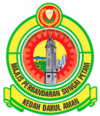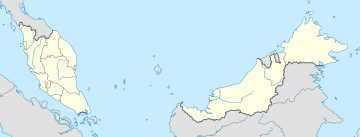Sungai Petani
This article needs additional citations for verification. (June 2019) |
Sungai Petani | |
|---|---|
City | |
 Flag  Seal | |
| Nickname(s): SP | |
 Sungai Petani Location in Malaysia | |
| Coordinates: 5°39′N 100°30′E / 5.650°N 100.500°ECoordinates: 5°39′N 100°30′E / 5.650°N 100.500°E | |
| Country | Malaysia |
| State | Kedah |
| Granted municipality status | 1 July 1994 |
| Government | |
| • President | Abdul Rashid Othman |
| Population (2010)[1] | |
| • Total | 443,458 |
| Time zone | UTC+8 (MST) |
| • Summer (DST) | Not observed |
| Postcode | 08xxx |
| Website | www |
Sungai Petani (abbreviated Sg. Petani or SP; Chinese: 双溪大年; Tamil: சுங்கை பட்டாணி) is a city in Kuala Muda District, Kedah, Malaysia. Sungai Petani is Kedah's largest city and is located about 55 km south of Alor Setar, the capital of Kedah, and 33 km northeast of George Town, the capital city of the neighbouring state of Penang.[2][3]
Culture[]
Bujang Valley[]

The Bujang Valley or Lembah Bujang, sometimes referred to as the Ancient Wonder of Kedah, is a rich historical site covering an area of about 400sq. km in Merbok (17 km from Sungai Petani), bounded by Bukit Coras (Choras Hill) and Gunung Jerai. This archaeological area was the site of an ancient Hindu-Buddhist kingdom that ruled the region from the 4th century AD. There is also an archaeological museum here which is known as The Lembah Bujang Archaeological Museum.[4] This museum displays more than 2,500 artifacts from Malaysia's earliest civilization that have been unearthed from the surrounding excavation sites. Gold, gems, ceramics, Hindu gods and beautiful Buddha stone statues dating from the third to 14th centuries are all on display, though its main feature is Chandi Bukit Batu Pahat, a reconstructed temple built to worship the Hindu god Shiva.
People from Sungai Petani[]
- Khairul Helmi Johari, Kedah captains and national football player
- Bala Ganapathi William, actor, director & TV host
- Baddrol Bakhtiar, national football figure plays for Kedah and national team
- Syed Amin Aljeffri, entrepreneur[citation needed]
- Chong Wei Feng, national badminton player[5]
Nearby[]
References[]
- ^ http://www.mpspk.gov.my/web/guest/population;jsessionid=0956D5C855629514252AA64B8F27ABAE[dead link]
- ^ "Key Summary Statistics For Local Authority Areas, Malaysia 2010" (PDF). Department of Statistics, Malaysia. Archived from the original (PDF) on 5 February 2015. Retrieved 19 April 2012.
- ^ "Population Distribution and Basic Demographic Characteristics, 2010" (PDF). Department of Statistics, Malaysia. Archived from the original (PDF) on 13 November 2013. Retrieved 19 April 2012.
- ^ "Lembah Bujang Archaeological Museum - Department of Museums Malaysia".
- ^ "Wei Feng CHONG". Badminton World Federation. Retrieved March 29, 2016.
External links[]
| Wikimedia Commons has media related to Sungai Petani. |
- Towns in Kedah
- Northern Corridor Economic Region




